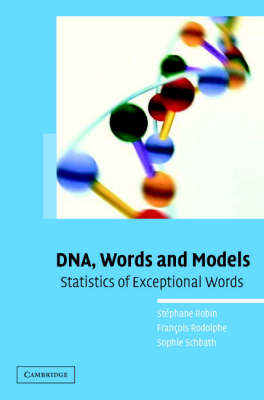
DNA, Words and Models
Statistics of Exceptional Words
Seiten
2005
Cambridge University Press (Verlag)
978-0-521-84729-2 (ISBN)
Cambridge University Press (Verlag)
978-0-521-84729-2 (ISBN)
One of the most important problems in computational biology is whether a particular gene sequence (mathematically, a 'word') is simply random or is of biological significance, for example, because of its frequency or location. This book introduces the mathematical and statistical ideas used in solving this so-called exceptional word problem.
An important problem in computational biology is identifying short DNA sequences (mathematically, 'words') associated to a biological function. One approach consists in determining whether a particular word is simply random or is of statistical significance, for example, because of its frequency or location. This book introduces the mathematical and statistical ideas used in solving this so-called exceptional word problem. It begins with a detailed description of the principal models used in sequence analysis: Markovian models are central here and capture compositional information on the sequence being analysed. There follows an introduction to several statistical methods that are used for finding exceptional words with respect to the model used. The second half of the book is illustrated with numerous examples provided from the analysis of bacterial genomes, making this a practical guide for users facing a real situation and needing to make an adequate procedure choice.
An important problem in computational biology is identifying short DNA sequences (mathematically, 'words') associated to a biological function. One approach consists in determining whether a particular word is simply random or is of statistical significance, for example, because of its frequency or location. This book introduces the mathematical and statistical ideas used in solving this so-called exceptional word problem. It begins with a detailed description of the principal models used in sequence analysis: Markovian models are central here and capture compositional information on the sequence being analysed. There follows an introduction to several statistical methods that are used for finding exceptional words with respect to the model used. The second half of the book is illustrated with numerous examples provided from the analysis of bacterial genomes, making this a practical guide for users facing a real situation and needing to make an adequate procedure choice.
Introduction; 1. Simple models for biological sequences; 2. Introduction to Markov chain models; 3. Taking heterogeneities into account; 4. Statistical properties of word occurrences; 5. Words with unexpected frequencies; 6. Words with unexpected locations.
| Erscheint lt. Verlag | 13.10.2005 |
|---|---|
| Zusatzinfo | Worked examples or Exercises; 14 Tables, unspecified; 7 Halftones, unspecified; 21 Line drawings, unspecified |
| Verlagsort | Cambridge |
| Sprache | englisch |
| Maße | 156 x 235 mm |
| Gewicht | 391 g |
| Themenwelt | Mathematik / Informatik ► Informatik ► Theorie / Studium |
| Informatik ► Weitere Themen ► Bioinformatik | |
| Mathematik / Informatik ► Mathematik ► Wahrscheinlichkeit / Kombinatorik | |
| Naturwissenschaften ► Biologie ► Genetik / Molekularbiologie | |
| ISBN-10 | 0-521-84729-X / 052184729X |
| ISBN-13 | 978-0-521-84729-2 / 9780521847292 |
| Zustand | Neuware |
| Haben Sie eine Frage zum Produkt? |
Mehr entdecken
aus dem Bereich
aus dem Bereich
Operationen- und Prozedurenschlüssel; Internationale Klassifikation …
Buch | Softcover (2023)
Deutscher Ärzteverlag
CHF 34,95
Buch | Softcover (2021)
Springer Spektrum (Verlag)
CHF 69,95


